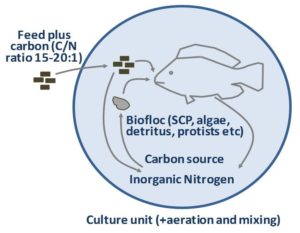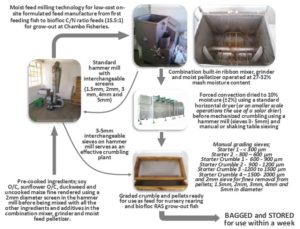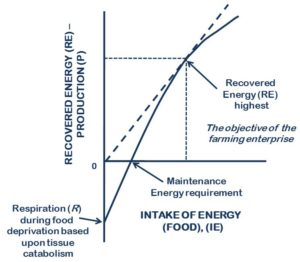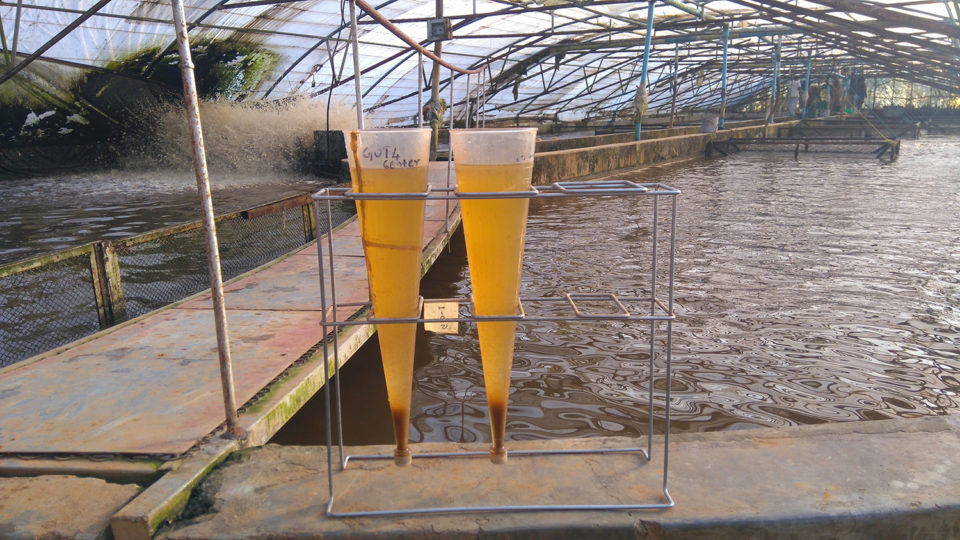Feeds and feeding systems at Chambo Fisheries in Africa

(Editor’s note: This is part 2 of a three-part series. Read part 1 here.)
Biofloc technology (BFT) is a new aquaculture practice currently revolutionizing the shrimp farming sector in Asia and South America. BFT is a sustainable and environmentally friendly method of aquaculture that controls water quality and harmful pathogens along with the value-added production of microbial protein feed for the aquatic farm system. Shrimp and tilapia especially benefit in BFT systems due to their ability to filter feed on microbial floc in the water column, reducing the costs of feeding.
The beauty of BFT is the mechanisms for the removal of ammonium from the water, given the use of feeds carrying a carbon to nitrogen ratio (C/N ratio) greater than 15:1 results in the dominance of heterotrophic bacteria as the major pathway for the removal of toxic nitrogenous compounds via assimilation into new bacterial cell biomass. BFT simultaneously provides an abundant source of “bacterial plankton” (biofloc: a clustered aggregation of microbial communities such as phytoplankton, bacteria, protists and dead particulate organic matter) also a rich source of good quality protein and nutrients for filter feeding fish and shrimp. BFT is like killing two birds with one stone. See Fig. 1 for a schematic of the process of BFT to promote nitrogen uptake by heterotrophic bacteria which then becomes a food source for tilapia and shrimp.

Acceptable water quality can be maintained over an extended period (>18 months at Chambo Fisheries) of continuous operation in well-engineered BFT tanks which prevent the accumulation of dead and oxidized solid material through effective elimination via the integration of a solids capture and removal component (see Part 1 for details).
Most fish farmers will agree that feed often makes up 55 to 65 percent of the final farm gate production cost in conventional tilapia culture systems viz. recirculated aquaculture system (RAS), lake-cage culture, greenwater pond farming etc. Chambo Fisheries has been able to routinely achieve FCRs averaging1:1 feeding a 20.2 percent protein feed (equal to a C/N ratio of 15.5: 1) raising Mozambique tilapia (Oreochromis mossambicus) and Shiranus tilapia (O. shiranus).
Such huge formulated feed fed protein shortfalls means that fish are able to “find” the balance of their needed protein ranging from 55 to 60 percent of total required protein intake via filter feeding on biofloc aggregations. This is not surprising considering the high carbon conversion efficiency via the “heterotrophic microbial loop” of around 40 to 60 percent into heterotrophic bacterial cell biomass, protein content of 30 to 60 percent on a dry matter (DM) basis and the very short trophic pathway (lower trophic energy losses) of microbial aquaculture systems; dissolved C + N → C + N in microbes → C + N in farmed organisms.
Specialized feeds produced on-site
Feeds including broodfish diets, starter feeds and specialized C/N ratio feeds are all produced on-site using a low-cost moist pellet milling plant which produces sinking pellets of medium to low water stability. The major components of the Chambo Fisheries type feed plant include a hammer mill and a combination grinder, mixer and moist feed pelletizer as well as a horizontal dryer and grading sieves for starter feed production on-site (Fig. 2).

Feed formulations for fish beyond 5 grams are all animal protein-free, based solely on pre-cooked oil seed meals and maize plus vitamin and mineral pre-mixes. Additives, in addition to a vitamin and mineral premix, include choline chloride, vitamin C, monocalcium-phosphate, an organic acid, molasses used as a nutritive binder and most importantly the use of mycotoxin absorbent which is mandatory under BFT conditions in Malawi due to prevalence of aflatoxin and other mycotoxins.
The ability to custom formulate feeds on-site allows for adjustments to the formulation with ease. During the start-up of BFT over the first 45 to 60 days feeds require additional vitamin C fortification and sometimes the addition of crushed garlic to improve the immune response in fish until the biofloc becomes mature. After three months of continuous operation mineral inclusion levels required to be reduced in BFT tanks at Chambo Fisheries particularly the transition metals such as copper (Cu), iron (Fe) and manganese (Mn) as these tend to accumulate and are recycled through the biofloc. An iterative metal homeostasis model has been constructed which allows for the optimization of customized diets for BFT by SAFF given responsive data derived from live systems.

Optimizing daily feed allotment
Best results raising 5- to 220-gram fish were achieved when feeding a 20.2 percent protein feed which provides a C/N ratio of about 15.5:1 based upon the use of bio-energetic feeding rate modes constructed by SAFF where FCR averaged 1:1. Here meal intervals were spaced 3 hours 30 minutes apart and the day’s first meal size was the largest at 45 percent of the daily feed allotment (dFA) in 20 to 120-gram fish. Larger fish above 120 grams were fed three meals per day spaced five hours apart where 50 percent of dFA was fed at first feeding early morning. Tests conducted using feeding trays indicated that all feed is consumed under the meal intervals, meal percentage of dFA and feeding rates applied within less than 5 minutes.
Feeding pressed pellets of moderate to fast sinking speed and low-water stability under BFT conditions where visibility is poor rendered feeding response highly subjective when feeding schedules were not delivered in time by management. Overfeeding BFT systems can rapidly deplete dissolved oxygen levels and/or result in excessive nutrients – in particular element concentrations (Cu, Fe, Mn etc.) – impair growth and reduce system stability, as well as increase feed costs. Conversely, underfeeding less than what is required for fish to express their full growth potential reduces profitability of the operation and in addition can result in a regression backwards to “greenwater” from “brown water,” affecting ammonium removal rates and therefore compromising system stability.
The objective of every fish farmer is to achieve maximum growth under the lowest food cost commonly referred to as the feed conversion ratio (FCR). Under BFT this objective is no different. In bioenergetics, this is referred to as the point where Recovered Energy (RE) is highest (see Fig. 3 adapted from Jobling, 2011 below).

While, the additive benefits of fish filter feeding on biofloc aggregations also requires to be factored into bioenergetic models when establishing the daily Digestible Energy (DE) contribution for dFA estimates. Optimizing feeding systems under BFT requires a basic understanding of bioenergetics and the energy costs of raising a kilogram of fish (1 kg in wet body weight gain in a cohort or population of fish as MJ DE/kg gain) and the use of appropriate feeding rate models.
Benefits of BFT to Chambo Fisheries
The key to harvesting the benefits of BFT at Chambo Fisheries lay in the following practices:
- The formulation and use of C/N ratio feeds – C/N ratio feed passage through the digestive system of tilapias rather than the addition of a supplemental carbon source to the culture water. This strategy permits the use of bio-energetic feeding rate models;
- Tuning feeding rates based upon the use of bio-energetic models built into a BFT decision support tool developed to guide feeding practices and assist with auditing achieved performance (feeding rates, feed conversion, Net Energy Retention (NER) and Net Protein Retention (NPR), input-output Nitrogen recovery ratio’s etc.);
- Manipulation of meal intervals and meal sizes at intervals pinned to anticipated fish size and water temperature influenced Gastric Evacuation Rates (GER) > 80 percent to maximize the digestive capacity of feed presented.
- Floc volume management to hold floc volumes in the range 20-30 ml/L as measured by an Imhoff Cone (Fig. 4) in a 35-minute settlement test (required for achieving a terminal reading).
Fig. 4: Imhoff Cones used to measure floc volumes (mL/L) at Chambo Fisheries.

Determining optimum feeding rates
Optimum feeding rates which count in the energy contribution of biofloc grazing by filter feeding tilapias at Chambo Fisheries was then discovered iteratively by manipulating the Natural Food Contribution factor (NFCf) added to a modified bioenergetic feeding rate model as follows;
dFA = (Wi * TDEN) * (1-NFCf) / DE
Where: dFA = Daily Feed Allotment, kg of feed; Wi = Weight increment, kg of biomass gain; TDEN = Theoretical Digestible Energy Need (TDEN) assuming 100 percent efficiency and zero waste as Mega Joules of Digestible Energy to achieve 1kg of biomass gain in a population or cohort of fish (fish size dependent model: TDEN = 0.009 X BW + 12.45 (R2 = 0.984)); NFCf = NFCf accounts for that portion of TDEN contributed by biofloc grazing found by deduction from inventory taking where NFCf, 0 – 1 (0=0 percent, 1=100 percent) and, DE = Digestible Energy estimate in Mega Joules per kilogram of the feed fed (MJ kg-1 of feed).
Inventory taking indicated a contribution range to TDEN in O. mossambicus and O. shiranus to repeatedly range between 20 percent (NFCf = 0.2) to 25 percent (NFCf = 0.25) of the daily Digestible Energy (DE) requirements of 5g to 220g fish under large-scale conditions at Chambo Fisheries when feeding a 20.2 percent protein feed (approx. C/N ratio of 15.5:1) where FCRs ranged between 0.9-1.2:1 and averaged around 1:1 (Table 1).
Kourie, BFT Pt. 2, Table 1
| Tank/cage designation | Tilapia species | Stocked weight (g) | Inventory weight (g, 21 days) | Realized TGC X 1000 | Avg. water temperature (Celsius) | Realized FCRs | NPR | NER | % over-or under-feeding estimate |
|---|
Tank/cage designation | Tilapia species | Stocked weight (g) | Inventory weight (g, 21 days) | Realized TGC X 1000 | Avg. water temperature (Celsius) | Realized FCRs | NPR | NER | % over-or under-feeding estimate |
|---|---|---|---|---|---|---|---|---|---|
| GOT 1 | O. mossambicus | 20 | 36 | 1.098945 | 25.5 | 1.01 | 78.78 | 41.6 | 0.67 |
| GOT 7 | O. shiranus | 91 | 124.9 | 0.884850 | 26.9 | 1.16 | 68.6 | 38.8 | 15.56 |
| GOT 7 (cage) | O. mossambicus | 127 | 147.6 | 0.463987 | 26.5 | 1.13 | 69.91 | 39.9 | 14.0 |
| GOT 7 | O. shrianus | 86.1 | 111.4 | 0.770363 | 24.5 | 0.87 | 90.69 | 51.0 | -12.55 |
Proximate composition of feed: 20.2% protein, 6.8% lipid, 48.9% NFE, GE 16.1MJ/kg, DE 11.02MJ/kg, C/N ratio 15.5:1
Percentage over- or under-feeding estimate based upon a target achievable FCR of 1:1 under biofloc conditions
TGC = Thermal Growth Coefficient [TGC = [(BW11/3 - BW21/3) / (T, °C * day(s))] * 1000
NPR = Net Protein Retention, % = [increase in carcass protein / protein fed] * 100
NER = Net Energy Retention, % = [increase in carcass energy / energy fed] *100
Bio-energetic feeding rate models have not been properly applied to biofloc tank culture of tilapia and process optimization studies by the global research community are needed. Then the work at Chambo Fisheries by SAFF represents first attempts to optimize feeding rates counting-in the contribution of biofloc grazing towards meeting a portion of the daily DE requirements of the fish reared.
Substantial work remains on customized feeds for BFT particularly the addition of synthetic amino acids in the C/N ratio feeds, reducing metal levels and optimizing the inclusion of lipid levels to create a “more-energy-dense” diet coupled with revisions of feeding levels. It may be possible to reduce FCRs below 1:1 under commercial conditions, thereby improving the efficiency of BFT further.
The merits of BFT as a competitive and sustainable alternative low-cost intensive feedlot technology for tilapia aquaculture are continued in Part 3 to follow.
Author
-

Ramon M. Kourie
Chief Technical Officer
SAFF – SustAqua Fish Farms (Pty) Ltd
14 Branch Lane, Blairgowrie, 2625
Johannesburg, South Africa
http://sustaquafishfarms.co.za
Tagged With
Related Posts

Responsibility
Optimizing tilapia biofloc technology systems, part 1
Chambo Fisheries, the world’s largest tilapia biofloc tank farm and the largest tank farm in Africa, has a multi-cohort, sequential, continuous production schedule.

Aquafeeds
Biofloc systems viable for tilapia production
Well-designed and managed biofloc technology systems are a viable alternative for production of various species like tilapia, to increase feed efficiency by lowering aquafeed protein requirements and to help reduce or eliminate effluent discharges.

Aquafeeds
Biofloc and clear-water RAS systems: a comparison
This study compared two types of indoor, shrimp culture systems: clear-water RAS and biofloc systems. Clearwater RAS had the edge in water quality, but shrimp in the biofloc treatment had a higher feed conversion ratio.

Aquafeeds
Biofloc consumption by Pacific white shrimp postlarvae
The stable isotopes technique with δ13C and δ15N can be used to determine the relevance of different food sources to shrimp feeding during the pre-nursery phase of Litopenaeus vannamei culture. During this trial, different types of commercial feed, microalgae, Artemia sp. nauplii and bioflocs were used as food sources.

